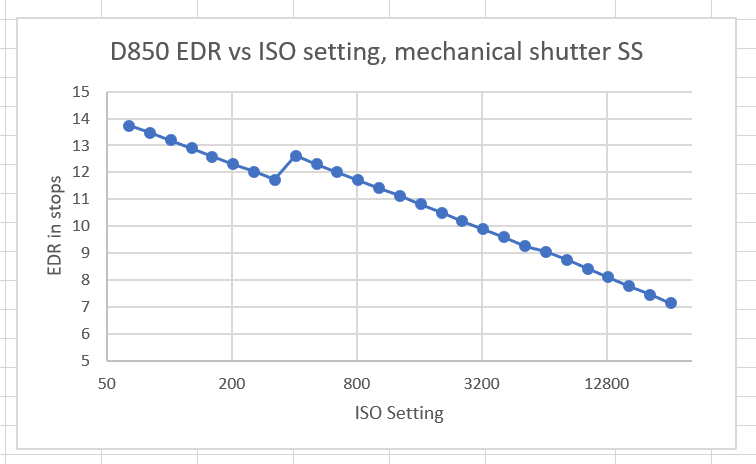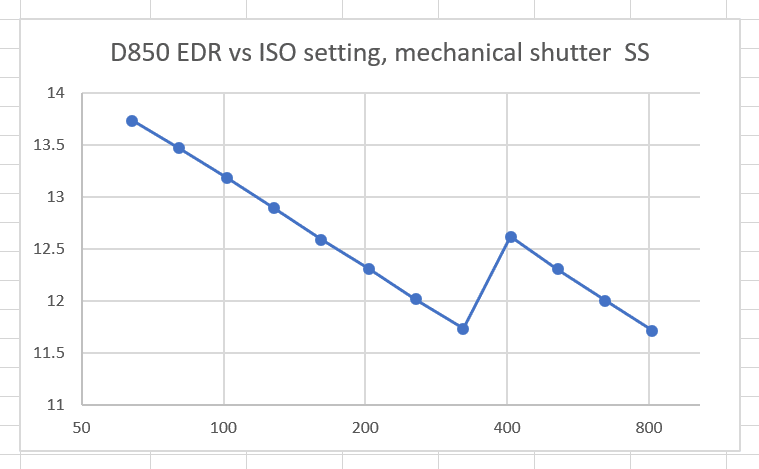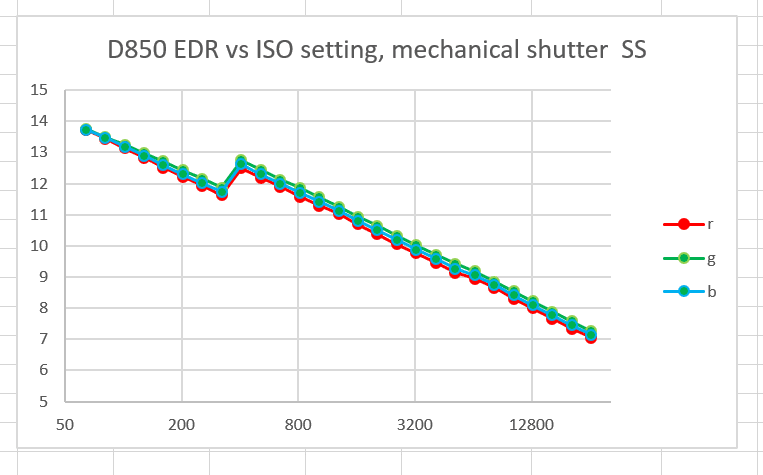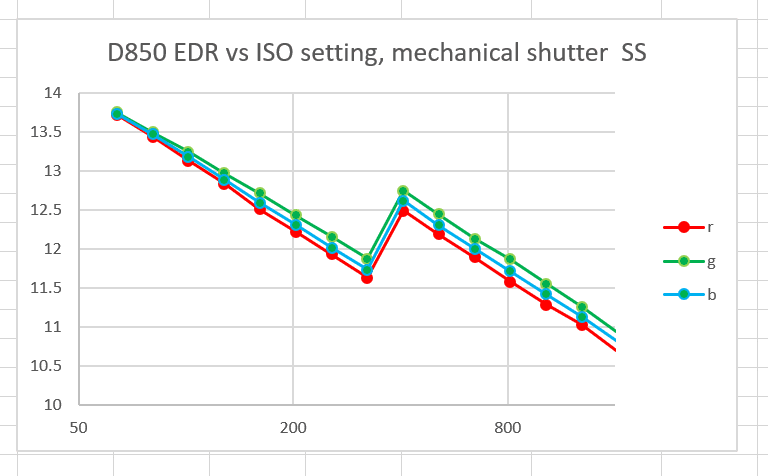This is the third post in a series of Nikon D850 tests. The series starts here.
Yesterday, I showed you some dark-file histograms from the D850, using the mechanical shutter set to 1/1600 second. Today, I’ll show you the result of an analysis of the same files I used for yesterday’s post. I measured the ratio between full-scale output and the dark-field (or read) noise (RN). That is called the Engineering Dynamic Range (EDR). I measured a 400×400 pixel central patch (200×200 for each raw channel) and averaged the results.
The jump in EDR when the camera is switched from ISO 320 to ISO 400 is due to a reduction in the capacitance associated with storing the charge in each pixel. This technology was developed by Aptina, who called it DR-Pix, and has been licensed by Sony and used in many of their alpha-series cameras.
Let’s take a closer look:
You can see that the EDR at ISO 400 is about the same as that at ISO 160. Therefore, pictures taken at ISOs 200, 250, and 320 will be noisier than at ISO 400, if the exposure is the same. You may need to use those ISOs to avoid clipping, but in that case, you probably should back all the way down to ISO 160.
Looking at the three different raw channels:
There appears to be a small, systematic bias in favor of the green channel.
Zooming in, we can see that is indeed the case:
This is due to the Nikon white balance prescaling. It’s small enough that it’s not going to be important in real photography, but I still wich Nikon wouldn’t do that.




Eric Calabros says
What’s the benefit of this upscaling?
JimK says
You mean the white balance prescaling? The advantage escapes me. I’m sure there must be one, because it’s a continuing feature of Nikon raw files.
Anton says
Nikon could do all us a favor and either fix this or add in a menu feature in ISO sensitivity settings that lets us block out ISO 200-320.
JimK says
The curves aren’t as dramatic when you factor in photon noise, but in general, I agree. My preferred implementation would be to leave the gain at the ISO 200 gain for those three settings, brighten the JPEG and JPEG preview images, and write a tag into the metadata that tells the raw developer how much brightening of the image it has to do. Kind of like what the GFX does at high ISOs.
Anton says
PS – Something I am noticing is that despite shooting the 850 at 0.0 EV, I’ve decided not to push .7 or 1 like I did with the 810 because highlights are often already clipped or near clipped even though the exposure is mainly to the left in the histogram.
Almost every import, my first step is to pull down highlights (in Capture 1) all the way to 100 and then adjusting exposure to the right.
JimK says
Before you decide what’s happening with the highlights, be sure to look at the files with RawDigger or Fast Raw Viewer…
Anton says
I will eventually. I haven’t installed it on my new computer yet.
jpgoube says
Well at 200, 250 and 320 iso the readout noise is greater than at 400, but there are other sources of noise….
The photonic noise, ie the noise inherent to the light itself because the photons come in random order, is higher at 400 iso than at 200. And the readout noise is very low, so the images will finally look more noisy at 400 than at 200 iso. Maybe the effect will be visible between 320 and 400 iso though
JimK says
First, photon noise does not vary with ISO setting; it varies with exposure. I mentioned the ameliorating effect of photon noise in the post, however. Bill Claff’s PDR captures the effects of both, and the bump is not as striking there, as I said. I have not done my own PDR measurements on the D850 yet.
jpgoube says
Well I assume that if you shoot the same scene at 200 iso instead of 400, the exposure will change accordingly
JimK says
I don’t select exposure that way. In fact, I think that, in general, that’s not a good way to pick exposure. I think the first thing you should do is pick the right exposure, then select ISO to manage clipping and read noise, usually in that order.
Ilkka Nissilä says
Since there are twice as many green pixels than red or blue, shouldn’t that result in higher SNR and DR for green?
JimK says
I just looked at one green raw plane at a time, so, no.